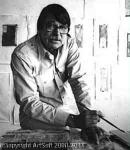Richard Diebenkorn
Richard Diebenkorn
Style: Expressionism; Color Field; Abstract Expressionism;
Place: Portland
Born: 1922
Death: 1993
Biography:
Richard Diebenkorn was an American painter and printmaker. His early work is associated with abstract expressionism and the Bay Area Figurative Movement of the 1950s and 1960s. In the late-1960's he began his extensive series of geometric, lyrical abstract paintings. Known as the Ocean Park paintings, these paintings were instrumental to his achievement of worldwide acclaim.
Richard Clifford Diebenkorn Jr. was born on April 22, 1922, in Portland, Oregon. His family moved to San Francisco, California, when he was two years old. From the age of four or five he was continually drawing. In 1940, Diebenkorn entered Stanford University, where he met his first two artistic mentors, professor and muralist Victor Arnautoff, who guided Diebenkorn in classical formal discipline with oil paint; and Daniel Mendelowitz, with whom he shared a passion for the work of Edward Hopper. Hopper's influence can be seen in Diebenkorn's representational work of this time. It was also during this time that he met Phyllis Antoinette Gilman.They were married in 1942
Diebenkorn served in the United States Marine Corps from 1943 to 1945. During the late 1940s and early 1950s, he lived and worked in various places: San Francisco and Sausalito (1946–47 and 1947–50), Woodstock, New York (1947), Albuquerque, New Mexico (1950–52), Urbana, Illinois (1952–53), and Berkeley, California (1953–1966). He developed his own style of abstract expressionist painting. After WWII, the focus of the art world shifted from the School of Paris to the US and in particular to the New York School. In 1946, Diebenkorn enrolled as a student in the California School of Fine Arts in San Francisco, now known as the San Francisco Art Institute which was developing its own vigorous style of abstract expressionism. In 1947, after ten months in Woodstock on an Alfred Bender travel grant, Diebenkorn had returned to the CSFA, where he adopted abstract expressionism as his vehicle for self-expression. He was offered a place on the CSFA Faculty in 1947 and taught there until 1950. He was influenced at first by Clyfford Still, who also taught at the CSFA from 1946 to 1950, Arshile Gorky, Hassel Smith and Willem de Kooning. He became a leading abstract expressionist on the west coast. In 1950 to 1952, Diebenkorn was enrolled under the G.I. Bill in the University of New Mexico’s graduate Fine Arts department where he continued to adapt his abstract expressionist style.
For the academic year 1952–53, Richard Diebenkorn took a faculty position at the University of Illinois in Urbana where he taught painting and drawing. In November and December of 1952 he had his first solo exhibit at a commercial art gallery, the Paul Kantor Gallery in Los Angeles, California.
In September of 1953 Diebenkorn moved to back to the San Francisco Bay Area from New York City, where he had spent the summer. He established his home in Berkeley, California, and lived there until 1966. It was during the first few years of this period that Diebenkorn abandoned his strict adherence to abstract expressionism and began to work in a more representational style. By the mid-1950s, Diebenkorn had become an important figurative painter, in a style that bridged Henri Matisse with abstract expressionism. Diebenkorn, Elmer Bischoff, Henry Villierme, David Park, James Weeks and others participated in a renaissance of figurative painting, dubbed the Bay Area Figurative Movement. His subject matter of this period includes interiors, landscapes, still lifes, as well as the human figure.
Diebenkorn began to have a measure of success with his art work during this period. He was included in several group shows as well as had several solo exhibits. In 1960 a mid-career retrospective is presented by the Pasadena Art Museum (now the Norton Simon Museum). Later, that fall the a variation of the show moved to the California Palace of the Legion of Honor in San Francisco.
It was In the summer of 1961, while he was a visiting instructor at UCLA , that Diebenkorn first became acquainted with printmaking when his graduate assistant introduced him to the printmaking technique of drypoint. Also, while in Southern California, was a guest at Tamarind Lithography Workshop (now the Tamarind Institute) where he worked on suite of prints which were completed in 1962.
Upon his return to Berkeley in the Fall of 1961, he began seriously exploring drypoint and printmaking with Kathan Brown at her newly established fine arts printing press, Crown Point Press. In 1965 Crown Point Press printed and published an edition of 13 bound volumes and 12 unbound folios of Diebenkorn's first suite of prints, 41 Etchings Drypoints (this project was the first publication of Crown Point's catalogue). Diebenkorn would not do any more etching again until 1977 when Brown renewed there artistic relationship. From then, until 1992, Diebenkorn returned almost yearly to Crown Point Press to produce work.
More...
Wikipedia link: Click Here














